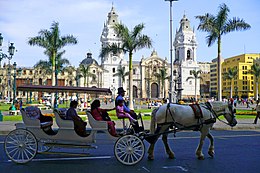
Back المركز التاريخي لليما Arabic Historia urboparto de Limo Esperanto Centro histórico de Lima Spanish Centre historique de Lima French Centro histórico de Lima Galician Cibiyar Tarihi ta Lima Hausa Pusat Sejarah Lima ID Centro storico di Lima Italian Sentro istorial de Lima LFN Centro Histórico de Lima Portuguese
| UNESCO World Heritage Site | |
|---|---|
 The Cathedral of Lima located in the main square of the historic center | |
| Location | Lima, Peru |
| Criteria | Cultural: (iv) |
| Reference | 500bis |
| Inscription | 1988 (12th Session) |
| Extensions | 1991, 2023 |
| Area | 259.36 ha (640.9 acres) |
| Buffer zone | 766.7 ha (1,895 acres) |
| Coordinates | 12°3′5″S 77°2′35″W / 12.05139°S 77.04306°W |
The Historic Centre of Lima (Spanish: Centro histórico de Lima) is the historic city centre of the city of Lima, the capital of Peru. Located in the city's districts of Lima and Rímac, both in the Rímac Valley, it consists of two areas: the first is the Monumental Zone established by the Peruvian government in 1972,[1] and the second one—contained within the first one—is the World Heritage Site established by UNESCO in 1988,[2] whose buildings are marked with the organisation's black-and-white shield.[a]
Founded on January 18, 1535, by Conquistador Francisco Pizarro, the city served as the political, administrative, religious and economic capital of the Viceroyalty of Peru, as well as the most important city of Spanish South America.[4] The evangelisation process at the end of the 16th century allowed the arrival of several religious orders and the construction of churches and convents. The University of San Marcos, the so-called "Dean University of the Americas", was founded on May 12, 1551, and began its functions on January 2, 1553 in the Convent of Santo Domingo.[5]
Originally contained by the now-demolished city walls that surrounded it, the Cercado de Lima features numerous architectural monuments that have survived the serious damage caused by a number of different earthquakes over the centuries, such as the Convent of San Francisco, the largest of its kind in this part of the world.[2][6] Many buildings of the are joint creations of artisans, local artists, architects and master builders from the Old Continent.[2] It is among the most important tourist destinations in Peru.
- ^ "Centro Histórico de Lima: Patrimonio Mundial". Sitios del Patrimonio Mundial del Perú.
- ^ a b c "Historic Centre of Lima". World Heritage Convention. UNESCO.
- ^ Tolentino, Scheila (9 May 2023). "Centro de Lima: ¿por qué algunas edificaciones tienen un escudo blanco y negro? Esta es la razón". La República.
- ^ Martínez Hoyos, Francisco (15 March 2018). "Lima, la joya del virreinato del Perú". La Vanguardia.
- ^ "Centro Histórico de Lima Patrimonio Cultural". UNESCO Cátedra. Universidad de San Martín de Porres.
- ^ Pereyra Colchado, Gladys (27 September 2020). "Los secretos de una Lima subterránea y su relación con el hallazgo en la plazuela San Francisco". El Comercio.
Cite error: There are <ref group=lower-alpha> tags or {{efn}} templates on this page, but the references will not show without a {{reflist|group=lower-alpha}} template or {{notelist}} template (see the help page).
© MMXXIII Rich X Search. We shall prevail. All rights reserved. Rich X Search
